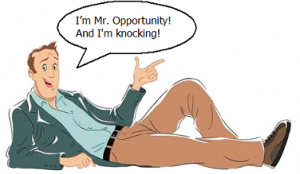Over the decades, I have observed that it is quite common for organizational leaders to try to use the word “opportunity” when talking about a problem.
I can understand the desire to do this – we typically think of “problems” as something to do with people.
But I find the emphamistic language… problematic.

There is a Honda marketing campaign in the USA that features a cartoon character named “Mr. Opportunity.” His tag-line is “I’m Mr. Opportunity, and I’m knocking.” The opportunity is an invitation to take advantage of discounted prices for Honda cars.
Words mean things.
An opportunity is something that I may, or may not, decide to pursue.
But in lean thinking, no problem can go unaddressed.
 Rather than a friendly cartoon character knocking on your door, a problem has kicked your door in and is standing in your living room. It must be dealt with, and dealt with quickly.
Rather than a friendly cartoon character knocking on your door, a problem has kicked your door in and is standing in your living room. It must be dealt with, and dealt with quickly.
It has to be contained, pushed back, and finally resolved to keep it from getting back in.
IF the process for doing these things is carried out correctly, there are opportunities for the organization to learn along the way. But in the vast majority of cases, the only way those opportunites get exploited is if the leaders insist on hearing what was learned. So even those “opportunities” shift to imperatives.
Friendly euphemism that soften the urgency do not help us. If we are to have a true problem solving culture, we have to be willing to call things what they actually are.
Mark,
I define ‘problem’ as a gap between expectations and reality. If reality is constant and expectations rise, it is an opportunity. If expectations are constant, and reality changes, it is an error/defect/’issue’/etc. Problem solving, then, is about closing that gap.
In truth, what matters is the selection process is the cost and the benefit. It can make sense to go after an opportunity first if the return is higher than that of fixing an error. Of course, I tend to place a big cost on defects that make it to the customer, so anything that impacts a customer tends to be a priority.
Jeff Hajek
http://www.velaction.com
How about “if reality is constant, and expectations rise” then there is NOW a gap between expectations and reality.
That gap MUST be closed, or expectations are not met… so I think it is still a problem.
Edited: I think that whatever is now blocking you from achieving the new expectation (target condition) is a problem.
Here at my company the difficulty that I face is that we all are very good at getting our jobs done in spite of problems. Our company was started by a guy in his garage 35 years ago who had lots of ingenuity. I think our unwritten motto is, “Oh yes we have problems, but we are very good at working around them.”
And so it’s very difficult to recognize a problem and hold it in our heads long enough to stop the process and fix it. There is a lot of inertia that keeps us moving (forward?) in spite of our problems.
Mark,
Exactly my point. It is the gap that is the problem, regardless of how the gap happened. Whether expectations rose or performance dropped, the resulting gap requires the same tools to close.
Jim,
You are facing a common problem. Your company’s culture rewards firefighters, not fire marshalls.
Nice thread starting here…
Jeff
Did you mean eu·phe·mism or is ephamism as new word that I can’t find in the dictionary.
Thanks!
The spell checking editor has been sacked.
🙂
Edited to add: So I was wondering why my browser’s spell checker didn’t catch that as it is usually pretty good. Then I remembered – I did it from the corporate laptop, and it only has….. Internet Explorer.
Just to complete the thought (10 years later):
If Reality rises and Expectations are constant, than the outcome is delighted stakeholders. We can act on both Reality and Expectations. If we proactively act on Reality, we can create delight; if we proactively act on Expectations, we can prevent disappointment.
@Jeff…. Your definition of what a problem is gives me goose bumps.
Preach!!!